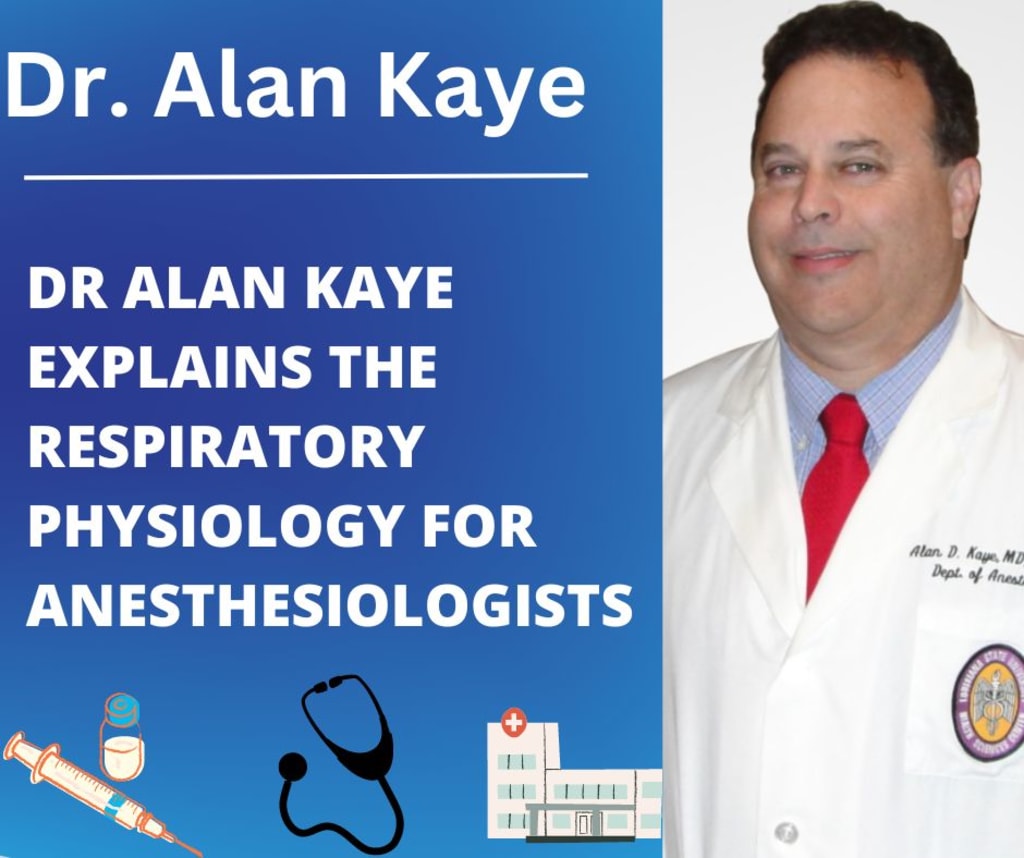Dr. Alan Kaye Explains The Respiratory Physiology for Anesthesiologists
Respiratory Physiology for Anesthesiologists

Learn the fundamentals of respiratory physiology from Dr. Alan Kaye, a renowned anesthesiologist, provides a comprehensive overview of respiratory physiology for anesthesiologists. Learn about the anatomy and function of the lungs, airways, and circulation as well as how these relate
Introduction:
According to Dr. Alan Kaye Respiratory physiology plays a crucial role in the field of anesthesiology. Anesthesiologists are responsible for managing and maintaining a patient's respiratory function during surgical procedures, ensuring optimal gas exchange, and preventing complications. Understanding the principles of respiratory physiology is essential for providing safe and effective anesthesia care. This article aims to provide an in-depth overview of respiratory physiology, focusing on key concepts relevant to anesthesiologists.
Ventilation:
Ventilation refers to the process of moving air in and out of the lungs. It is a fundamental component of respiratory physiology. Anesthesiologists closely monitor and control ventilation to maintain appropriate oxygenation and carbon dioxide elimination. Key parameters in ventilation include tidal volume (the volume of air inhaled or exhaled with each breath), respiratory rate (the number of breaths per minute), and minute ventilation (tidal volume multiplied by respiratory rate).
Gas Exchange:
Gas exchange occurs at the alveolar level, where oxygen (O2) is taken up by the blood, and carbon dioxide (CO2) is eliminated from the body. The partial pressure of oxygen (PaO2) and carbon dioxide (PaCO2) in arterial blood are vital indicators of gas exchange efficiency. Anesthesiologists monitor and optimize oxygenation and ventilation to maintain adequate PaO2 and PaCO2 levels during anesthesia.
Pulmonary Function Tests:
Pulmonary function tests (PFTs) assess lung function and provide valuable information about a patient's respiratory status. Key PFT parameters include forced vital capacity (FVC), forced expiratory volume in one second (FEV1), and the FEV1/FVC ratio. These tests help identify pre-existing respiratory conditions, assess baseline lung function, and guide anesthetic management decisions.
Respiratory Mechanics:
Optimizing ventilation during anesthesia requires an understanding of respiratory mechanics. Compliance, resistance, and airway pressure are essential concepts in respiratory mechanics. Compliance refers to the lung's ability to stretch and expand, while resistance refers to the ease of airflow through the airways. Anesthesiologists utilize mechanical ventilation strategies and adjust ventilator settings to maintain appropriate compliance, minimize resistance, and prevent barotrauma or volutrauma.
Oxygen Transport:
Oxygen transport involves the delivery of oxygen from the lungs to the tissues. It depends on the oxygen-carrying capacity of hemoglobin and factors influencing its binding and release from hemoglobin. Anesthesiologists consider various factors affecting oxygen transport, such as arterial oxygen content (CaO2), cardiac output, and hemoglobin concentration, to ensure adequate tissue oxygenation.
Respiratory Control:
The respiratory control system regulates ventilation and maintains arterial blood gas homeostasis. Central and peripheral chemoreceptors sense changes in oxygen and carbon dioxide levels and adjust ventilation accordingly. Anesthesiologists manipulate respiratory control through pharmacological agents, such as opioids or anesthetics, to achieve specific ventilation goals during surgery.
Acid-Base Balance:
Acid-base balance is crucial for maintaining normal physiological function. Anesthesiologists closely monitor arterial blood gas values, including pH, PaCO2, and bicarbonate (HCO3-) levels. Understanding the principles of acid-base physiology allows anesthesiologists to diagnose and manage disturbances, such as respiratory acidosis, respiratory alkalosis, metabolic acidosis, or metabolic alkalosis, during the perioperative period.
Respiratory Complications:
Anesthesiologists must be prepared to identify and manage respiratory complications that may arise during anesthesia. Common complications include hypoventilation, hyperventilation, bronchospasm, aspiration, and airway obstruction. Understanding respiratory physiology aids in recognizing early signs of complications and implementing appropriate interventions promptly.
About the Creator
Dr. Alan Kaye
Dr. Alan Kaye, MD, Ph.D. , is the Professor and Chairman of the Department of Anaesthesiology at LSU Health Sciences Center in New Orleans since January 2005.






Comments
There are no comments for this story
Be the first to respond and start the conversation.